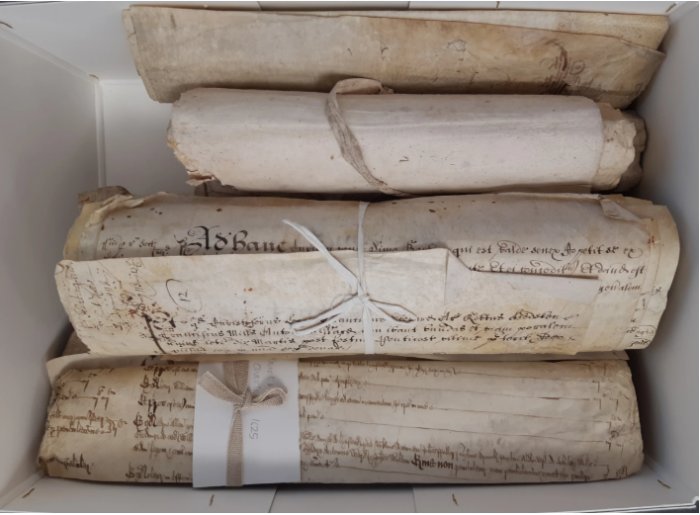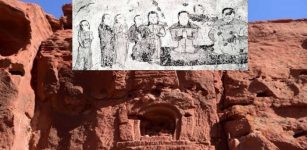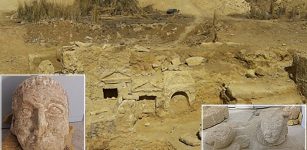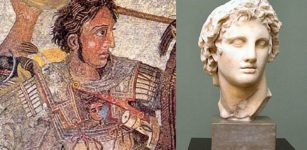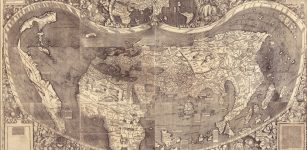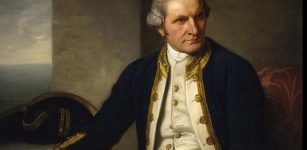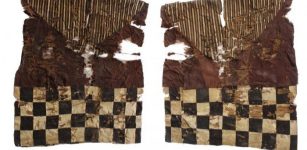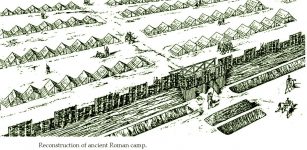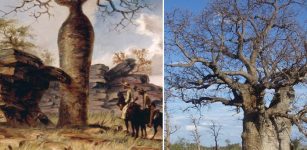Rare Stories Of Merlin And King Arthur Discovered In Medieval Manuscript Hidden In Plain Sight
Jan Bartek - AncientPages.com - The tale of King Arthur, the legendary British ruler known for defending Britain against Saxon invaders during the late 5th and early 6th centuries AD, has been a subject of fascination for centuries. This enduring narrative, enriched by the adventures of King Arthur and the enigmatic magician Merlin, continues to intrigue audiences.
Left: A depiction of King Arthur by Charles Ernest Butler (1864-1933). Public Domain - Right: Merlin illustration by Howard Pyles to The Story of King Arthur and His Knights (1903). Public Domain. Middle: Piuece of the deciphered manuscript. Credit: University of Cambridge. Image compilation: AncientPages.com
Recent discoveries have added new dimensions to this epic saga. In 2019, a fragile manuscript fragment from the 13th century was found at Cambridge University Library. It had been hidden as part of a binding in a 16th-century archival register. This fragment contains rare medieval stories about Merlin and King Arthur. It is identified as part of the Suite Vulgate du Merlin—a French-language sequel to King Arthur's legend within the Lancelot-Grail cycle. Although this cycle was once widely read in medieval times, fewer than 40 manuscripts survive today, each uniquely handwritten by scribes between 1275 and 1315.
The manuscript, which had endured through the centuries, was repurposed in the 1500s as a cover for a property record from Huntingfield Manor in Suffolk, owned by the Vanneck family of Heveningham.
The inner front cover of the manuscript as it was discovered. Some of the folds, including flaps and turn-ins, make reading and accessing the text hidden beneath particularly difficult without damaging the material. Credit: University of Cambridge.
This led to its remarkable discovery being complicated by its condition—folded, torn, and stitched into the book's binding—making it nearly inaccessible for Cambridge experts to examine or verify its origins.
Following this discovery, a pioneering collaborative project emerged. It highlighted the efforts of the University Library’s Cultural Heritage Imaging Laboratory (CHIL), combining historical research with advanced digital techniques to reveal the manuscript's secrets without causing harm to this unique document.
"It was first thought to be a 14th-century story about Sir Gawain, but further examination revealed it to be part of the Old French Vulgate Merlin sequel, a different and extremely significant Arthurian text," says Dr. Irène Fabry-Tehranchi, French Specialist in Collections and Academic Liaison at Cambridge University Library, who was among those who first recognized the importance of the find.
During the medieval period, every manuscript was meticulously copied by hand, making each one unique and reflective of the variations introduced by individual scribes. This particular manuscript is thought to be part of the shorter version of the Vulgate Merlin. Small errors, such as using "Dorilas" instead of "Dodalis," are valuable to Dr. Fabry-Tehranchi and her colleague Nathalie Koble (ENS Paris) in tracing its lineage among surviving manuscripts.
The careful execution of this manuscript, featuring decorated initials in red and blue, provides additional insights into its origins and suggests it was produced between the late 13th and early 14th centuries.
Written in Old French—the language prevalent among the court and aristocracy in medieval England after the Norman Conquest—this fragment belongs to Arthurian romances intended for a noble audience, including women. It narrates two significant episodes from the conclusion of Suite Vulgate du Merlin. Credit: University of Cambridge
The first part describes how Christians triumphed over Saxons at the Battle of Cambénic, highlighting Gauvain's heroics with his sword Excalibur, his horse Gringalet, and his supernatural abilities, alongside his brothers and father King Loth against Saxon Kings Dodalis and Moydas, Oriancés, and Brandalus.
The second passage depicts a courtly scene during the Feast of the Assumption of the Virgin Mary, when Merlin appears at King Arthur's court disguised as a harpist. This moment underscores Merlin's magical abilities and emphasizes his significant role as the king's advisor.
“While they were rejoicing in the feast, and Kay the seneschal brought the first dish to King Arthur and Queen Guinevere, there arrived the most handsome man ever seen in Christian lands. He was wearing a silk tunic girded by a silk harness woven with gold and precious stones which glittered with such brightness that it illuminated the whole room." (A translation from the Suite Vulgate du Merlin manuscript found at Cambridge University Library)
The condition of the fragment posed a significant challenge due to its fragility, marked by tears and folds that complicated handling. Traditional conservation techniques may have required physically removing the binding to unfold the fragment, which could have resulted in irreparable damage.
To address this, the team chose an in situ preservation approach. This method enabled them to maintain the fragment as a representative example of 16th-century archival binding practices while utilizing advanced technology to unfold and digitize it virtually.
“It’s not just about the text itself, but also about the material artifact. The way it was reused tells us about archival practices in 16th-century England. It’s a piece of history in its own right,” says Dr. Fabry-Tehranchi, explaining the importance of preserving the fragment in its original state.
Sally Kilby (Conservation Department) and Błażej Mikuła (CHIL) carefully photograph inside the folds of the manuscript. Credit: University of Cambridge
A multidisciplinary team comprising curators, conservators, and imaging specialists from across the University of Cambridge, including departments such as Archives and Modern Manuscripts, Conservation & Heritage, and Collections and Academic Liaison, all worked together with CHIL to analyze and digitize the fragment.
"This project was a fabulous opportunity to employ all possible advanced imaging techniques from our photographic arsenal. And each of them brought something very important to light. This resulted in the creation of a set of unique digital objects which placed the original fragment in a whole new context and has transformed our understanding of it," Maciej M Pawlikowsk, Head of The Cultural Heritage Imaging Laboratory (CHIL) at Cambridge University Library said in a press release.
Dr. Fabry-Tehranchi described the process as “like solving a puzzle.” "If this had been done 30 years ago, the fragment might have been cut, unfolded, and flattened. But today, preserving it in situ gives us a crucial insight into 16th-century archival practices, as well as access to the medieval story itself."
Beyond revealing the fragment’s story of Merlin, this project has established a new benchmark for the conservation and digitization of medieval fragments.
"This project was not just about unlocking one text—it was about developing a methodology that can be used for other manuscripts. Libraries and archives worldwide face similar challenges with fragile fragments embedded in bindings, and our approach provides a model for non-invasive access and study."
The recent discovery has generated significant interest among researchers and conservators, particularly those at the UK’s National Archives. They are eager to investigate how these techniques could be utilized within their own collections. The team behind the project aims to encourage additional research into medieval manuscripts that may be concealed in surprising locations.
Although the tales of King Arthur and Merlin have been recounted for centuries, advancements in modern technology continue to reveal new insights and chapters in this enduring narrative.
The digital results of the project are now available for everyone to explore online via the
Cambridge Digital Library.
Written by Jan Bartek - AncientPages.com Staff Writer



